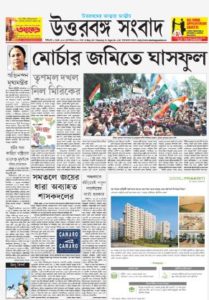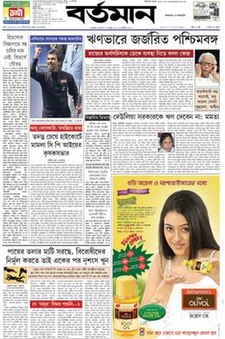Bengali wedding or what it is called in Bengali as ‘Biye’ is not just a day-long occurrence but a festival rich in tradition spanning multiple days. It is not just a union between two people but a ceremony where two families come together and become one. A ‘Biya’ is divided into basically three parts: Pre-wedding rituals, wedding rituals and post-wedding rituals. The entire episode is defined with the gathering of friends and family, good food, glamorous clothes and jewellery and religious rituals. Let’s explore how the entire event goes ahead.
A traditional Bengali arranged marriage is facilitated by a matchmaker called ‘Ghotok’. They are usually friends or relatives and can be from any side. They introduce the families and on certain day parents of the bride or groom along with other relatives go to the other party’s house to formalize the marriage known as ‘Paka Kotha’. On an auspicious day after that elders from the groom and the bride’s side visit each other’s place and bless the boy and the girl with clothes and gold ornaments. This formal occasion is known as ‘Ashirwad’. Food being an integral part of Bengali culture, all aspects of a Bengali Biye is accompanied by elaborate lunch or dinner. ‘Aai Budo Bhaat’ is such a ceremony where the bride-to-be has her last meal in her parent’s household. Women of the household on both the sides play an integral part in a few sacred rituals prior to the main wedding ceremony. Some of these rituals are ‘Ananda Nadu’ which is associated with coconut, sweets and puffed rice, ‘Dhodhi Mangal’ early morning ritual on both the groom and bride’s family, ‘Holud kota’ grinding of turmeric for anointing the bride and groom. ‘Vriddhi’ is a solemn occasion where the ancestors are invoked and are usually performed by a paternal uncle.
Early morning of the day of the wedding is accompanied by quite a few traditional rituals on both the bride and groom’s side. One such important ceremony is ‘Gaye Holud’. Prior to that, ‘Adhibas Tattwa’ is received by the groom’s family from the bride’s side which includes fish, sweets, curd, paan, clothes, etc. During ‘Gaye Holud’ the groom is bathed after applying turmeric paste and the same turmeric is sent to the bride’s house along with ‘Gaye Holud Tattwa’ for the bride to take bath. This is followed by ‘Sankha porano’ ritual in the bride’s household where the bride wears the sankha and pola bangles symbolic of a married Bengali woman.
The main wedding rituals commence with ‘Bor Boron’ that is welcoming the ‘Bor’, the groom to the bride’s place. The groom is accompanied by a trail of ‘Bor Jatri’, members of the groom’s house as well as his friends headed by a guardian known as ‘Bor Korta’ and the groom’s best man ‘Nid Bor’ who is the youngest member of the groom’s family. The groom is then seated in the ‘Chadnatola’ which is the wedding altar and is offered new clothes by the person from the bride’s side that performs ‘sampradan’.
Thereafter, is the ceremony of ‘Saat Paak’ where the bride is carried on a wooden seat called ‘piri’ by her brothers and circled around the groom seven times. The bride all this time hides her face behind beetle leaves which she holds in her hand. After ‘Saat Paak’ is ‘Subho Dristi’ when the bride removes the beetle leaves and the bride and groom glances at each other for the first time. The bride continues to sit on the ‘piri’ carried by her brothers and the ceremony of ‘Mala Bodol’ is carried out which is the exchange of flower garlands. This entire process is full of enjoyment and fun accompanied by the sound of conches and ‘ullu’.
The solemn Vedic ceremony of ‘Sampradan’ takes place after that where an elderly male member of the bride’s family hands her over to the groom. Followed by that is yagna and the ritual of ‘Saptapadi’ which is a bit different from ‘phere’ which happens in North Indian weddings. In the ‘Saptapadi’ ritual of Bengali marriage, the bride steps on seven laid out betel leaves and the groom follow her moving with his foot the stone called ‘nora’ which is used for grinding spices. Later, ‘anjali’ is offered to the fire using puffed rice by the bride and groom and the brother of the bride helps in the process. The last ritual of the wedding is ‘Sindor daan’ where the groom offers vermillion to the bride’s hair parting which is symbolic of Hindu married women. The entire evening is celebrated with guests, friends and relatives and a huge table and menu are spread out with delicious traditional and contemporary dishes to relish upon which quintessentially includes fish preparations and sweets like rosogolla. The bride and groom stay that night in ‘basor ghor’ kept awake by friends and relatives with jokes and merrymaking. Next morning happens the ritual of ‘bashi biye’ where in the priest’s presence, Sun god is worshipped.
Bengali wedding is incomplete without the post-wedding ceremonies which happen in the groom’s household. Day after the wedding ceremony is the farewell ceremony called ‘biday’ which is a moment of sorrow and joy in the bride’s household. The new bride is welcomed to the groom’s house with the rituals of ‘bodhu boron’. The bride enters the house after being welcomed by the mother-in-law stepping on milk and alta. This night is known as ‘kalratri’ and the bride and groom are separated. On the third day after the wedding is the ceremony of ‘bou bhaat’. The bride cooks for the first time in the groom’s household and the groom formally takes the responsibilities of the bride’s basic needs known as ‘bhaat kapor’. This is followed by a reception of family, relatives and friends who are introduced to the bride and again a huge menu is laid out to the guests. The last tradition of the entire ceremony is ‘phool sajja’ where friends of the groom decorate the bed of the newly wedded couple and flower, clothes and sweets come from the bride’s house.
The ritual of ‘dira gaman’ is observed after a few days from the wedding. This marks the newly wedded couple visiting the bride’s house for the first time after the wedding ceremony. With this auspicious occasion, a Bengali wedding ceremony comes to an end and the bride and groom and their families are unified in a forever bond.
Earlier, these elaborate affairs were managed by friends and relatives but these days when everyone’s lifestyle have changed and joint family structures have broken up into nuclear families, quite a few of these ceremonies are managed by event managers and catering agencies. We, at releaseMyAd have helped simplify Bengali marriage by providing the service of finding the future bride or groom. Apart from the traditional method of employing ‘ghotoks’ people trust newspaper advertisements to find their match. releaseMyAd has made matrimonial ad booking for Bengali community easy and hasslefree in the newspaper of their choice. The portal has been trusted for over a decade and has served more than 3 lakhs, happy customers. Through releaseMyAd you can book ads in popular Bengali newspapers like Anandabazar Patrika, Bartaman, Aajkal and also English dailies like Times of India and The Telegraph. We cover more than 100 newspapers all over India.
To place a Bengali matrimonial advertisement in any newspaper throughout India click on https://www.releasemyad.com/newspaper/cat/matrimonial/bengali and proceed on our self-serve platform. If you have any query and you are facing any difficulty in the booking process feel free to get in touch with our customer support team on Phone/ WhatsApp number 9830629298. You can also reach us via 24*7 Live Chat support or drop an email to book@releasemyad.com with all details.



